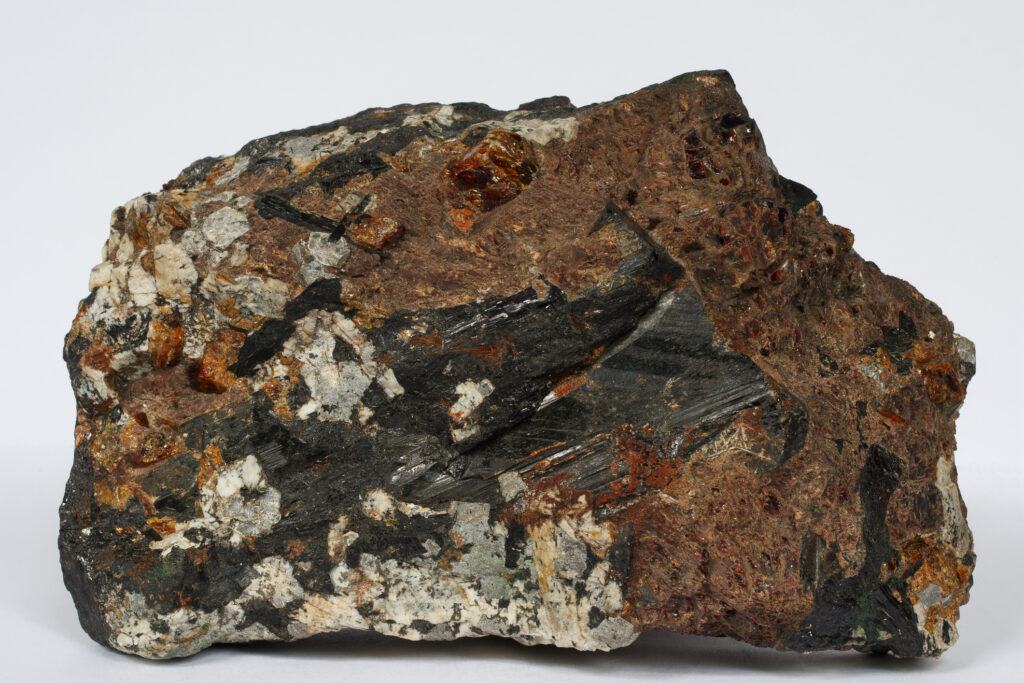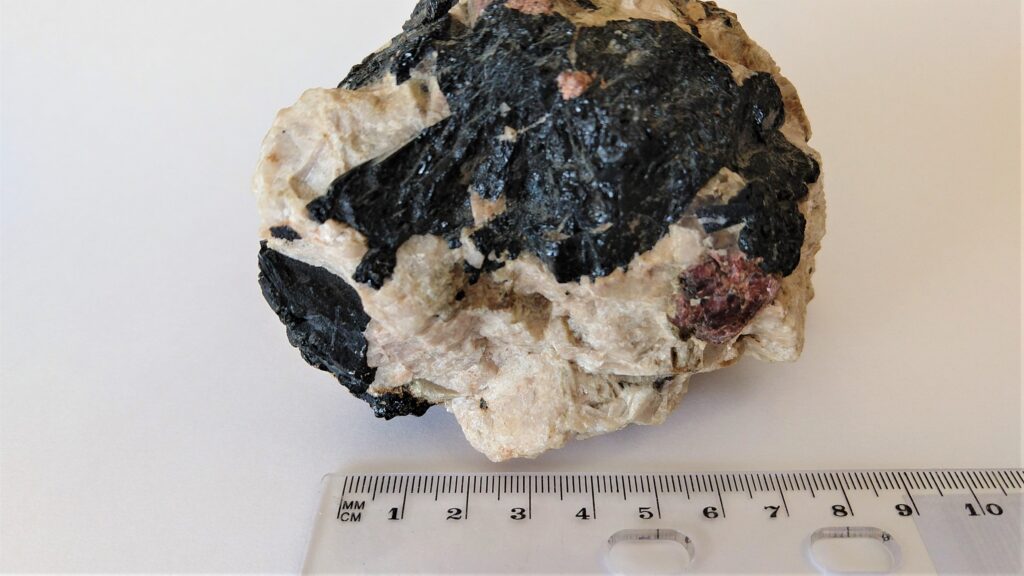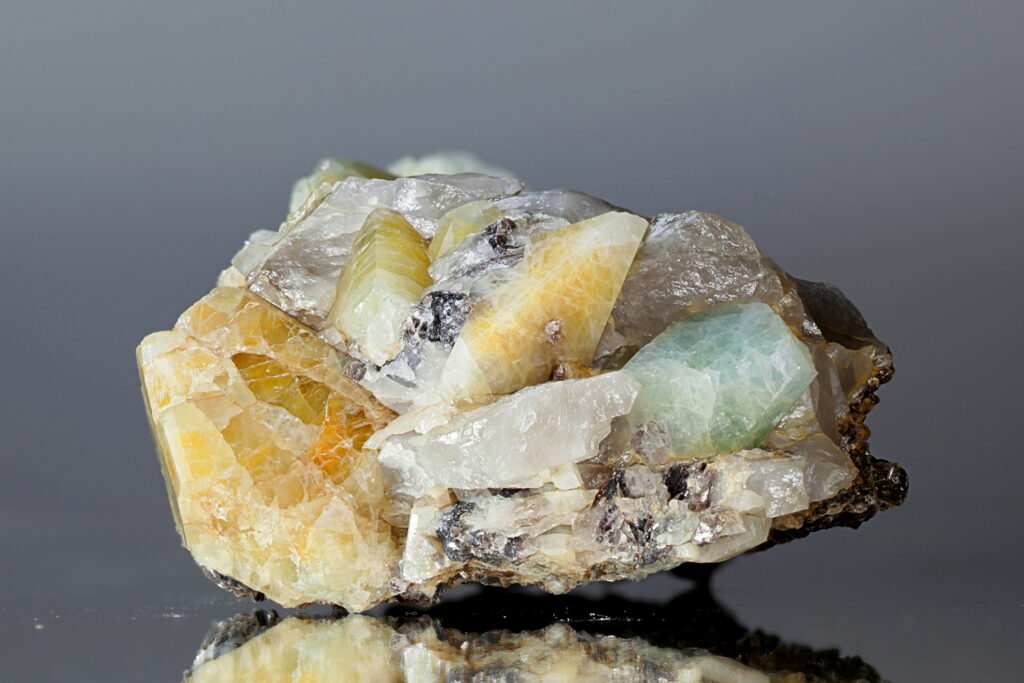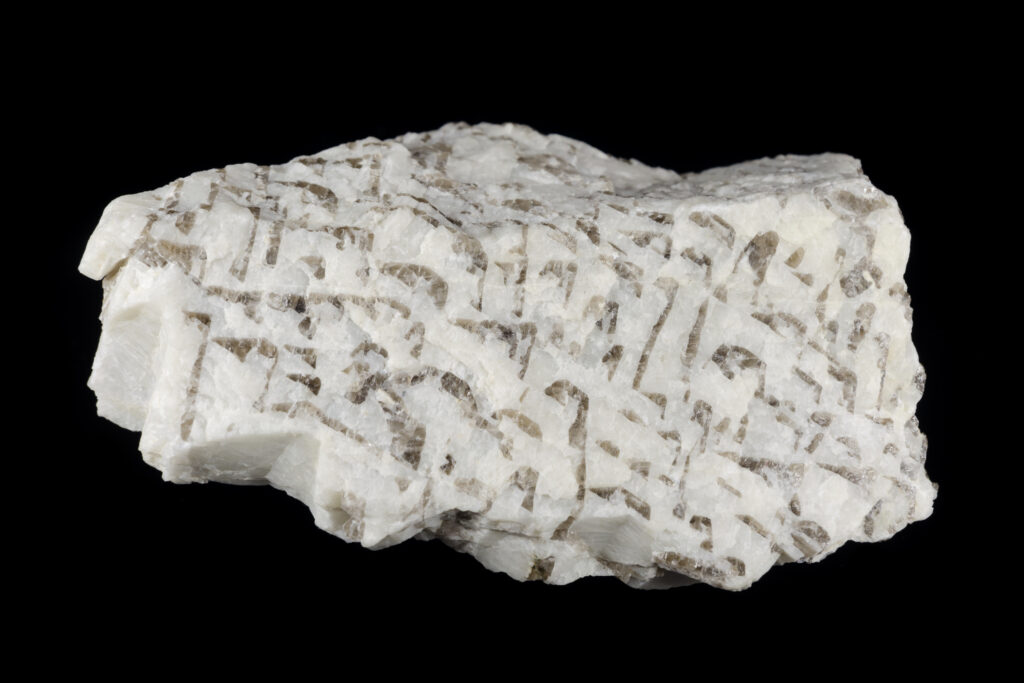Pegmatite is one of the most unique and varied rock types you can find. Most people who aren’t that into rocks aren’t even familiar with it but, for those in the know, it is one of the coolest rocks out there. Pegmatite is very popular with collectors and hobbyists because it often contains very large and attractive crystals.
Identifying pegmatite can sometimes be a challenge, especially if you aren’t familiar with what it looks like. However, identifying pegmatite and its many varieties is a relatively simple process once you know what to look for.
Pegmatite is an intrusive igneous rock defined by its very large, interlocking crystals that can range in size from 1 cm to over 1 meter. It is usually primarily composed of quartz, feldspar, and mica, but often includes rarer minerals and gemstones. Pegmatite forms in the last stages of magma crystallization
While pegmatite is a clearly defined rock type, there are many different varieties that can appear quite different from one another. It is fairly unique in that it isn’t generally identified by its mineralogy, but rather purely by its texture. I’ll walk you through how to identify pegmatite, what it looks like, and where it can be found.
What Does Pegmatite Look Like?
Pegmatite is not an overly common rock, so there are a lot of people who have no idea what it looks like. But, chances are, almost everyone has seen pegmatite at least a few times in their lives, even if they weren’t aware of it at the time. It is actually pretty easy to recognize once you have a general understanding of what to look for. So, what does pegmatite actually look like?
Pegmatite has very large, interlocking crystals, generally over 1 cm in size but usually much larger than that. The crystals are interlocking, with no space between them. Pegmatite usually has an overall light color due to its mineralogy and lacks any internal structural features like layering or banding.

While most pegmatite meets this general description, there is a pretty wide spectrum of pegmatites than can look significantly different from one another. The difference in their appearance is driven by the mineralogy of each type of pegmatite and the differences in their textures (crystal sizes).
Color is Driven by Mineralogy
The rock type ‘pegmatite’ is not defined by its mineralogy, which means that you can find pegmatites made from almost any type of crystals. The color of pegmatites is entirely determined by the minerals it is made from, and they can vary quite a bit from one specimen to another.
Most pegmatites have mineralogy very similar to granite. These types of pegmatites are often descriptively referred to as ‘granitic pegmatite’. The two major minerals present in all granites are quartz and feldspar, with mica also being fairly abundant. Each of these minerals can present itself in different ways. Feldspar, in particular, can look quite different from rock to rock depending on the specific type of feldspar that is present.
Quartz usually appears in pegmatite as translucent, light gray, or off-white. In polished pegmatite or granite (as you have likely seen in countertops) it sometimes feels like you can see below the surface of the rock. This is because the quartz crystals are transparent or translucent, allowing you to see through them. Some varieties may have more impurities which make the quartz crystals an opaque gray or white color. In any case, quartz is a significant contributor to granitic pegmatite’s overall light color.
Feldspar has much more variety than quartz. It is actually a group of minerals that can be divided into two main types: plagioclase feldspar and potassium feldspar (K-spar). These two types of feldspar look quite different from one another, and can even vary significantly in appearance themselves. More than one type of feldspar may be present in pegmatite.
K-spar is somewhat more abundant in pegmatite than plagioclase, but both are common. For the purposes of identifying a rock as a pegmatite, distinguishing between the two is not necessary. However, there are some easy-to-spot differences that can help you see the difference and further understand your rock.
Both K-spar and plagioclase feldspar can be white, but k-spar is also very commonly salmon-pink or even darker pink, bordering on red. Plagioclase feldspar usually has visible striations in its crystals that may be visible if the individual crystals are large enough.
The most common accessory minerals (minerals found in relatively low amounts) in pegmatite are mica and amphibole. The micas will either be muscovite or biotite, both of which form very flaky ‘books’ as crystals in the rock. Muscovite is very light or even translucent, while biotite is very dark. Amphibole is a large group of minerals, but will always look like dark, blocky crystals interspersed throughout the pegmatite.
Texture of Pegmatite
The defining feature of pegmatite is its texture. All pegmatite is very coarse-grained, meaning the individual crystals are 1 cm in size or larger (often significantly larger). This texture is known as ‘pegmatitic’, and it forms when highly water-saturated magma cools slowly at the edges of magma bodies, allowing for the formation of very large crystals.
The crystals in pegmatites can be exceptionally large, up to 1 meter or more in size. These finds are rare but are a good example of just how large the crystals can grow. The crystals grow until they run out of room when they run into one another as they solidify, leaving no void space between them.
While all pegmatite, by definition, has pegmatitic texture, it is also possible (and even common) to describe their texture in other ways. Rocks can be described as having more than one texture as long as the texture types are not mutually exclusive.
Pegmatites are also technically ‘phaneritic’, which simply means that the individual crystal grains can be seen with the naked eye. However, pegmatitic texture is much more specific and descriptive, so it is best just to refer to pegmatite as such.
The quartz and feldspar in pegmatite often display a fairly distinctive texture of their own. This ‘graphic’ texture loosely resembles scribbled letters or writing. In this case, you might describe a rock as being a ‘pegmatite with graphic feldspar’.
How to Identify Pegmatite
Pegmatite has such a distinct look that you might think that identifying it is a trivial matter. While that is often the case, that mindset often leads people to misidentify other rock types as pegmatite. As with all rocks, it is important to take a methodical approach when identifying pegmatite.
To identify pegmatite, first observe the individual grains of the rock. They should be crystalline and very large (1 cm across or more) and interlocking with one another. Look for quartz, feldspar, and mica, which are very common in pegmatites. There should be no visible porosity, banding, or layering.
A rock must meet all of these requirements to be considered a pegmatite:
- Igneous – Formed from cooling magma, with interlocking crystal grains.
- Very Coarse-grained – Pegmatitic texture with very large crystals easily visible to the naked eye
- Massive – No internal structures or layering

If your rock meets all of those criteria then it is very likely a pegmatite, or at least something very closely related.
It can sometimes be difficult to distinguish between granite and pegmatite, especially when the crystal sizes are around 1 cm in size – the borderline between coarse-grained and very coarse-grained. In these cases, I like to look at the smaller crystals in the rock and apply an identification based off of them. Just remember that identifying rocks (especially without sophisticated lab tests) is often a subjective exercise and as long as you can justify your label your answer is as good as anyone else’s!
Tip: This article is part of my igneous rock identification series. To read more about how to identify all igneous rocks, check out my article here.
When observing and identifying a rock like pegmatite it can often be useful to use a hand lens like this one from Amazon. This allows you to see the individual crystal grains more clearly and often helps you identify the specific species of minerals present in a rock.
What Is Pegmatite Made Of?
As I mentioned above, pegmatite is almost entirely defined by its texture, not by its mineralogy. But all rocks are made from one or more minerals, and in order to fully understand a rock like pegmatite, you have to know what those minerals are.
Pegmatite is usually granitic in composition, made from large amounts of quartz and alkali feldspar with smaller amounts of plagioclase feldspar, mica, and amphibole. However, some pegmatites may have compositions similar to other igneous rock types. Some gemstones like emerald can only be found in pegmatite.
This description is somewhat vague, but that is out of necessity. Pegmatite can be made of a wide variety of minerals, depending on the magma and conditions under which it formed.
In general, pegmatite can be grouped into three main types. Geologists often refer to these types when describing a specific pegmatite in order to give a general sense of its mineralogy.
- Granitic Pegmatite – Mineralogy similar to granite, dominated by quartz, feldspar, and mica
- Nepheline Syenite Pegmatite – Mineralogy similar to nepheline syenite, dominated by alkali feldspar, nepheline, and pyroxene
- Gabbroic Pegmatite – Mineralogy similar to gabbro, made mostly of pyroxene and plagioclase feldspar.
There are more types of pegmatite than this, but they are comparatively rare. Of these three main types, granitic pegmatite is by far the most common.
Some geologists prefer to use a different, more specific means of describing a pegmatite’s mineralogy that identifies specific minerals in order of increasing relative abundance. For example, a generic granitic pegmatite might be referred to as ‘hornblende-feldspar-quartz pegmatite’ if it is primarily made up with quartz with lesser amounts of feldspar and hornblende.

Where Is Pegmatite Found?
By now you might be wondering where you can find some pegmatite for yourself. Or maybe you’ve already found a rock that you suspect might be pegmatite and you’re wondering if it occurs in your are. While not nearly as abundant as many other volcanic rocks, pegmatite is fairly common and can be found in locations all over the world.
In general, pegmatite is found on the margins of large igneous intrusions near large bodies of granite or gabbro. It most commonly forms in locations with a history of significant igneous intrusions and near dikes and sills. Pegmatite is also sometimes found in association with low-grade metamorphic rocks.
Because pegmatite forms beneath the surface of the earth, the vast majority of it isn’t visible or accessible to us. But, through the tremendous power of plate tectonics and erosion, large mountain ranges of plutonic rocks (including pegmatite) are fairly common throughout the world.
Pegmatite is usually composed of relatively hard minerals (quartz and feldspar) which make it incredibly durable. Once it is exposed to the surface it takes a long time for it to break down, especially since its crystals are so large.
You can look for pegmatite formations near you using this excellent interactive map from the USGS. I have a video about how to use this tool in my Practical Rock Identification System, plus even more information on how to identify pegmatite and other rocks.
Usually, you’ll find pegmatite formations near other igneous rocks like granite, syenite, and gabbro. These rocks tend to form in large masses, with pegmatite occurring on their perimeter.
How Does Pegmatite Form?
We’ve learned all about what pegmatite looks like, what it is composed of, and generally where it’s found, but I have only briefly touched on how it’s actually formed. The creation of pegmatite is a fascinating process that always follows a few simple rules but can vary significantly in the details, which is the reason pegmatite can look so different from one sample to another.
Pegmatite forms in the last stages of magema crystallization, when water is pushed to the edges of the magma body. Pockets of water-saturated magma with much lower viscosity form, allowing for the free movement of molecules. The molecules can rapidly move and arrange themselves into very large crystals.
Relatively large crystals in phaneritic rocks like granite are usually associated with slow cooling. The crystals have time to arrange themselves into visible crystals, despite the high viscosity of the magma. However, this is not thought to be the case with pegmatites.
In pegmatites, the crystals grow to such great size because the magma from which they form is far less viscous than normal. Almost all magma contains some amount of water. As large magma bodies cool inside the earth, solid minerals begin to form and the water that was mixed in is slowly separated out from the melt and pushed towards the edges of the magma body (called a batholith when it is very large).
As the water becomes more concentrated, it is still heavily laden and mixed with molecules from the magma. But all of the water is much less viscous than the pure magma was, so those molecules are free to move around and attach to one another. They find crystals which have begun to form and then attach themselves, making the crystals even larger.
Sometimes there are some relatively rare molecules in this mixture that end up forming into gemstones and other minerals of economic value. Not all pegmatites show this tendency, but the ones that do are heavily targeted by mining operations.
The crystals continue to grow until they run into one another, at which point they continue to grow around or through each other and there is no space left.
The majority of pegmatites form in this way on the edges of batholiths (very large magma intrusions), but sometimes this same process takes place in smaller events like dikes and sills.

What Is Pegmatite Used For?
Chances are, you have probably seen pegmatite in your day-to-day life more often than you realize. Pegmatite has been in use for thousands of years because of its durability, strength, beauty, and its propensity to contain valuable minerals.
Pegmatite is often a target of commercial mining operations for the extraction of rare minerals and gemstones such as emerald, garnet, and aquamarine. It is sometimes slabbed and polished for use in construction and countertops.
What really sets pegmatite apart is its ability for its large crystals to accept a polish. Many of the highly polished ‘granite’ countertops you’re used to seeing are actually pegmatites, and they are made possible by the fact that quartz and feldspar are easily brought to a high shine.
The largest economic interest in pegmatites is definitely for its large gemstones and other rare minerals. Pegmatite mines often produce very nice crystal specimens that fetch a high price on the open market. However, most pegmatites do not contain anything much more exotic than quartz and feldspar crystals.
This article is part of my rock identification series. To learn more about identifying rocks, check out my full in-depth guide here.
